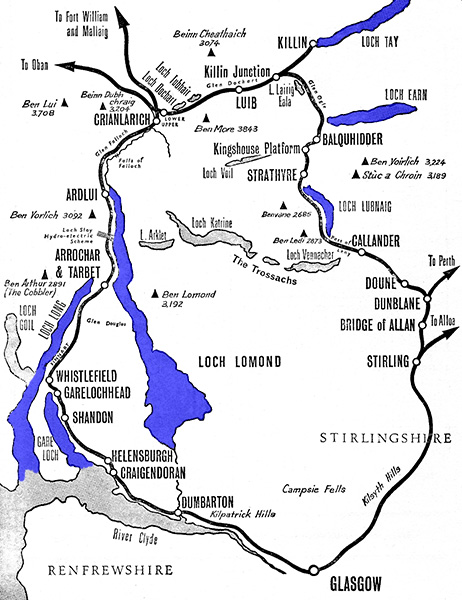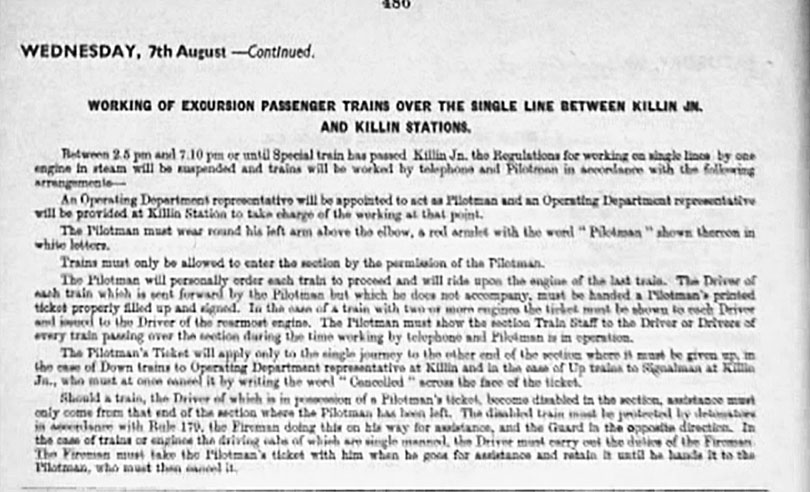Six Lochs Land Cruise
Introduction

The "Six Lochs Land Cruise" was a regular excursion that ran from 1958 to 1965.
It normally ran from Glasgow every Sunday from late May till late-August/early September. Additional tours were run between Easter and autumn on holidays and during the summer season from a variety of Central Scottish departure points often tied in with local fair holidays. The tours were popular and often the Glasgow departures required a relief train to be added.
Passengers were given generous layovers at Callander, Killin and Crainlarich. By 1963 Helensburgh was sometimes substituted for Crainlarich, Killin was occasionaly omitted.

The image shows a Swindon Cross-Country DMU in the early 1960s at Crainlarich Upper on a Six Lochs land Cruise from Gourock. Stuart Rankin.
Each train would do a circular tour, normally in an anti-clockwise direction, via Stirling / Callander / Crainlarch / Arrochar & Tarbet, and would also cover the Loch Tay branch from Killin Junction to Killin. Some trains ran in the clockwise direction.
They came to an end after the 1965 season with the closure of the Dunblane to Crianlarich line.
The route
Most tours started at, or would pass through, Glasgow. The standard service travelled in an anti-clockwise direction.
Nowadays trains for Fort William/Mallaig and Oban all start from Glasgow Queen Street and these destinations are considered to be the West Highland Line, but until autumn 1965 only the Fort-William/Mallaig services departed from Queen Street using the West Highland Railway / LNER route via Helensburgh to Crainlarich (Upper, the current station).
Oban services departed from Glasgow Buchanan Street and ran via Stirling, Dunblane and Callander using the Callander and Oban Railway / LMS route. At Crainlarich they used the Lower station and passed underneath the West Highland Line, and there was a connecting spur joining the two lines.
For the 1959-1963 seasons Glasgow departures of the Six Lochs Land Cruises used Buchanan Street station for outward journeys in the anti-clockwise direction (via Stirling/Callander). They would return to Glasgow Queen Street via the West Highland route although they would deposit their passengers in the Low Level platforms, unlike the service trains which used the upper level.

In 1964 and 1965 only Queen Street station would be used for the Glasgow departures.
The six lochs were:
- Loch Lubnaig
- Loch Earn
- Loch Tay
- Loch Lomond
- Loch Long
- Gare Loch
These have been coloured blue on the map, which has been taken from the 1964 advance information tour brochure.
The first part of the anti-clockwise tour would be fairly uneventful until the first stop at Callander, where ample time was provided to have a stroll through the town, and visit the river. Departure was through the Pass of Leny which led the the peaks of Ben Ledi and Benvane, these were on one side of the line as the first Loch, Loch Lubnaig, was on the other. After passing through the stations of Strathyre and Balquidder there was Loch Earn to be seen before the climb up Glen Ogle. When reaching Killin Junction the train would reverse and take the day trippers to Killin for another break.
At Killin the passengers would have to walk a mile to see the third Loch - Loch Tay. During the layover the train would sometimes be used to operate the standard branch service providing a connection at Killin Junctin with the main line train. Departing from Killin the tour headed back to Killin Junction then down through Glen Dochart. On reaching Crainlarich the passengers would dismount at the Lower station for a wander around the village before rejoining the train in the Upper station. The train, after dropping off the passengers at Lower headed a little further towards Oban before reversing onto the link line that took it up to the West Highland Line and into the Upper station.
The journey south was then through Glen Falloch which led to the north end of Loch Lomond, the fourth Loch on the itinerary, on which the paddle steamer "Maid of the Loch" could sometimes be seen in action. The final two Lochs were both sea lochs - first Loch Long, seen after passing through Arrochar & Tarbet, and finally the Gare Loch which it followed after the aptly name Garelochhead station. This Loch opened into the Clyde Estuary which the train would now follow eastbound after joining the North Clyde suburban network at Craigendoran on the last part of the journey into Glasgow.
Killin Branch
This was normally worked under the "one engine in steam" system and For the excursions special arrangements had to be made. Here is an example from 1963, courtesy of John Paton:

Tickets
This is the ticket prices for the regular Glasgow Sunday departures (as shown in the Advance Information booklets.
| 1959 | 1960 | 1961 | 1962 | 1963 | 1964 | 1965 |
|---|---|---|---|---|---|---|
| 10/- | 10/- | ? | 12/6 | 12/6 | 13/- | 14/- |
The DMUs
As far as is known DMUs were always used for the tours, which required three reversals (at Killin Junction, Killin and Crainlarich) during the journey, and were promoted for their better visibility of the scenery.
All the types of DMUs normally allocated to the Scottish Region at the time seem to have been used. Most common usage seems to be Craven twins (Class 105s) and Derby triples (Class 107s), photographs exist of GRC&W twins (Class 100s), Met-Camms (Class 101s), Swindon Cross-Country triples (Class 120s) and a Swindon Inter-City 79xxx series set being used. Notes also indicate that the Ayrshire Swindon Inter-City sets (Class 126s) worked at least one tour.
Land Cruises
On the railways excursions had run as "Land Cruises" since at least 1928[1] and the London Midland Region had been running DMU Land Cruises since 1955 - the "John Peel Land Cruise" in West Cumberland.
In Scotland "the first land cruise by diesel train left Glasgow Buchanan Street station on 29 July, when about 500 visitors were accommodated in an eight coach diesel train" noted the August 1958 issue of the ScR staff magazine[2]. The trip took the route that would become the standard for the Six Lochs tour, but it was just one of three Land Cruises run by the ScR that featured in the article, one being from Glasgow/Paisley to Largs/Ayr and the other from Aberdeen to Keith.
Some other examples of other Scottish Region Land Cruises were the "Scott Country Land Cruise" and the "North Berwick and Dunbar Land Cruise", two examples from the 1960 advance brochure.
The Six Lochs tour was not the only regular DMU excursion to travel over the West Highland lines, but these were much less frequent. One example was a circular tour that took in Fort William and Oban, the transfer between these two stations was by boat (steamer).
Further Information
The only article I've seen about the excursions was in the January 2006 "Railway Bylines" magazine. There are various bits of information and photographs in magazines and books and I've noted on the following pages where I have found these. If you have come across any further notes or images please let me know.
I would also be interested in scans of literature relating to these trains that I can add to these pages, such as handbills or special traffic notices.
1958

The first Six Lochs Land Cruise ran on Tuesday 29 July 1958. It travelled on the standard anti-clockwise circuit using four two-car Met-Camm sets. It is seen preparing to leave Killin. British Railways.
On this first date the DMU was used during its Killin layover to provide one of the regular service trains connecting with a main line train at Killin Junction.
It is believed that only one more Six Lochs tour ran in 1958 (in an article on a 1959 tour it notes it is the first ever DMU to ascend from Craigendoran to Helensburgh as "in 1958 two Land cruise trains descended" this section[3]).
References
Introduction / 1958
1959 Season
1960 Season
1961 Season
1962 Season
1963 Season
1964 Season
1965 Season


